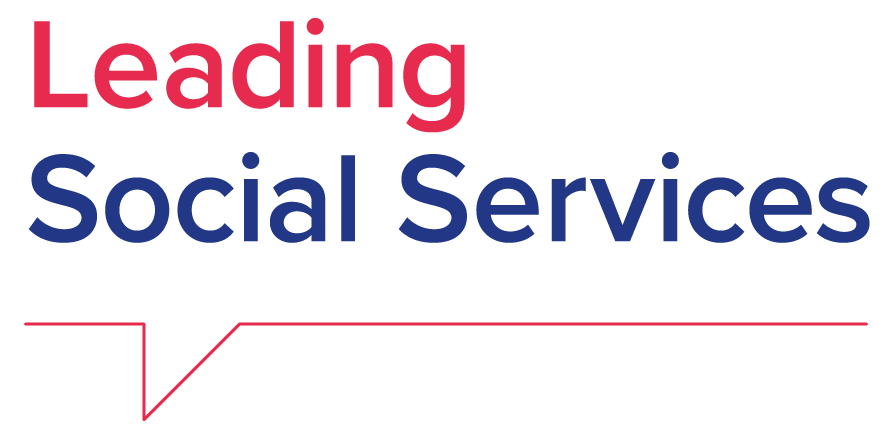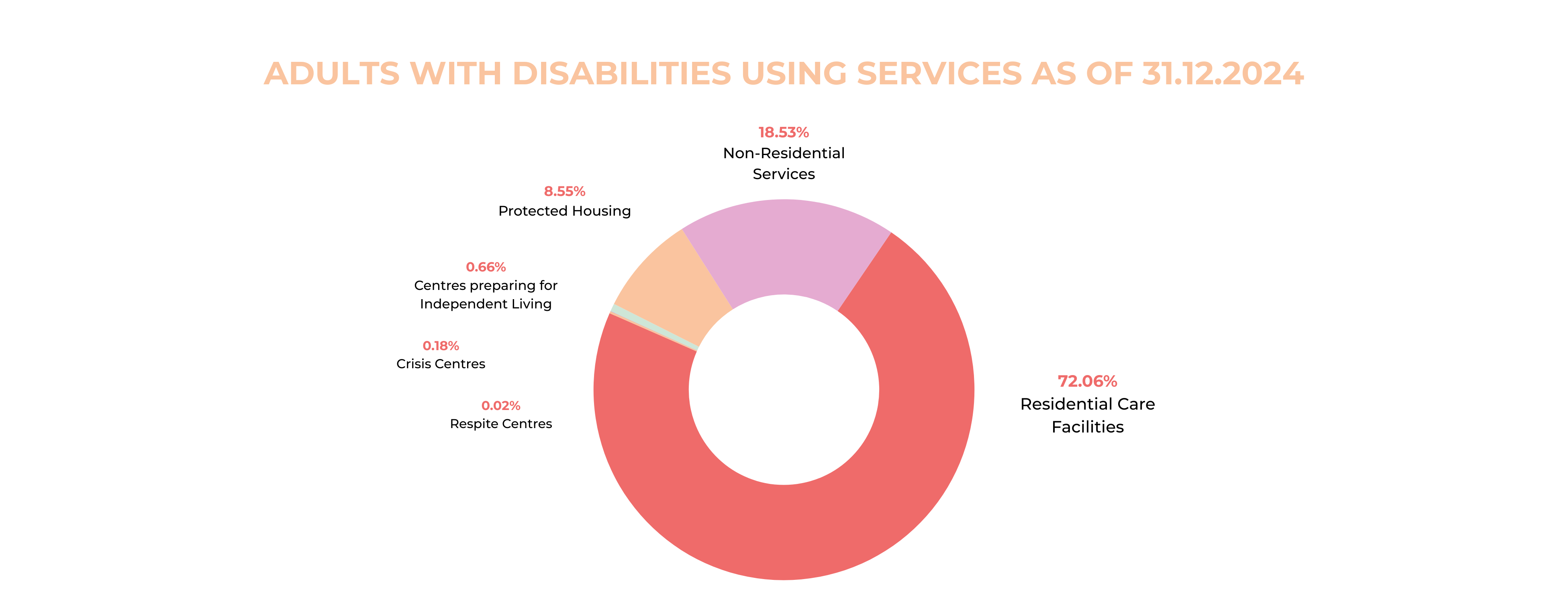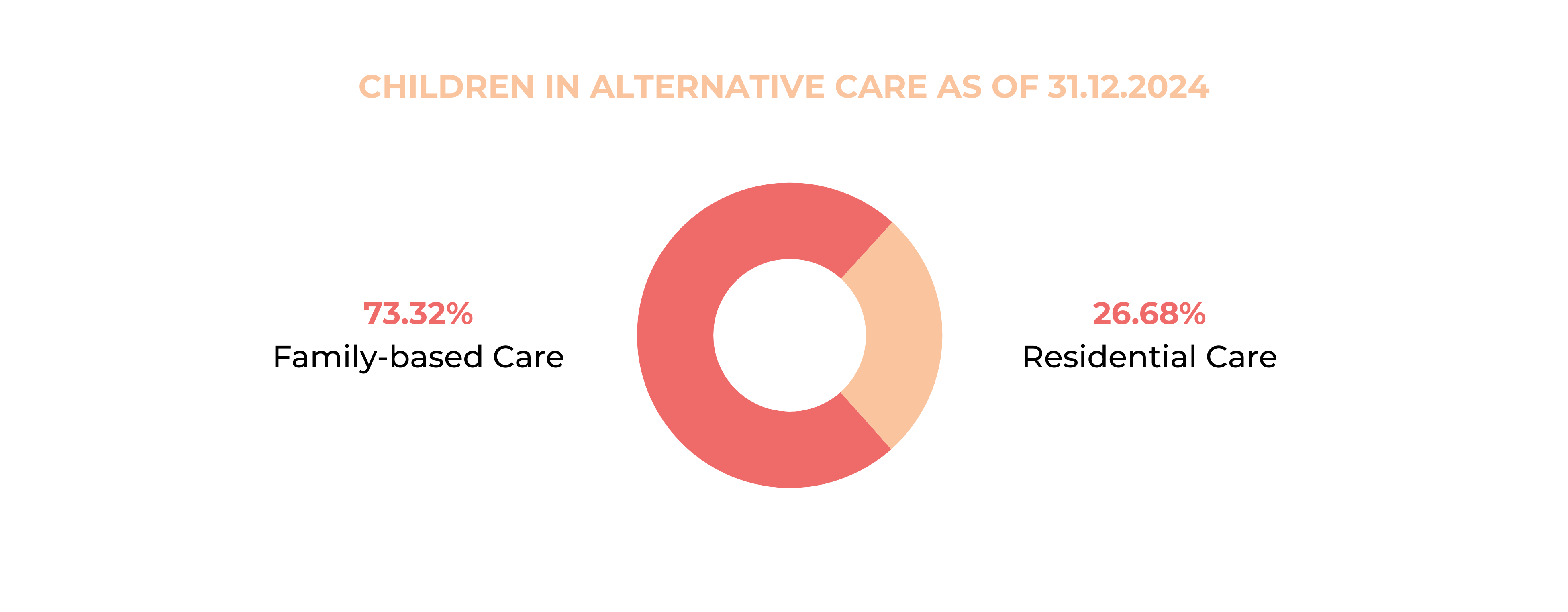Recommendation
Romania should invest in a sustainable system of community-based services for people with disabilities to maintain the quality and relevance of these services in the long term. This would prevent re-institutionalisation and protect the quality of life of people with disabilities, fulfilling the deinstitutionalisation reform that started in 2023.
Social Services Legislation
Right to access social services
✅ People’s right to access social services is recognised in Law 292 of 20 December 2011, which regulates the general framework for the organisation, operation, and financing of the country’s social assistance system. Social assistance is guaranteed to any person who, due to economic, physical, mental, or social reasons, is unable to ensure social needs, either temporarily or permanently, through their own efforts or other means.
Definition of social services
✅ Article 2 (3) of Law 292 of 20 December 2011 states that social assistance in Romania, through specific measures and actions, aims to develop individual, group, or collective capacities to ensure social needs are met, increase quality of life, and promote the principles of social cohesion and inclusion.
National social services catalogue
✅ Government Decision 867 of 14 October 2015, modified and completed by Government Decision 354 of 25 March 2021, lists the country’s social services and the framework regulations for their organisation and functioning. These services include:
- Regional centres for processing and accommodation of asylum seekers and individuals granted protection.
- Respite centres for families of children with disabilities.
- Residential care and health and social support centres for older people and chronically ill patients in a terminal phase.
- Residential, day, and support centres for older people.
- Residential and day centres and community services for adults with disabilities.
- Residential centres for children in the protection system.
- Residential care and support centres for mothers and children.
- Residential centres for youth in difficulty.
- Social services aimed at providing accommodation and care for pupils, students, and young people from families in difficult situations.
- Residential and support centres for other categories of individuals in dependent situations.
- Home care services for older people, people with disabilities, and people with care needs.
- Day centres for children and families with children.
- Day centres for victims of domestic violence and for offenders.
- Information and counselling centres for victims of domestic violence.
- Residential and day centres for people with substance addictions.
- Residential, day, and support centres for victims of human trafficking.
- Residential, day, and support centres for homeless people.
- Outreach services for homeless people and people with addictions.
- Food distribution centres for individuals at risk of poverty.
Social assistance benefits, on the other hand, are regulated under Law 292 of 20 December 2011 and include minimum guaranteed income, child allowances, heating aid, disability allowance, and family support allowance.
National social services strategic plan
✅ The National Strategy on Social Inclusion and Poverty Reduction 2022-2027, approved by Government Decision 440 of 30 March 2022, sets out the government’s measures aimed at reducing the share of the population at risk of poverty or social exclusion by 2027 by at least 7% compared to 2020. The foreseen measures include social counselling and guidance, early intervention programmes, community development initiatives, social assistance, emergency social services, temporary accommodation, rehabilitation programmes, social reintegration services, and support for independent living.
According to Article 2 of the Government Decision, the objectives and measures foreseen for the 2022-2027 period fall under the responsibility of public authorities and shall be financed through their budgets.
Responsibilities of national, regional, and local authorities
Law 292 of 20 December 2011 defines the responsibilities of national, regional, and local authorities as follows.
National authorities must:
- Develop social assistance policies and promote the rights of families, children, older people, people with disabilities, and other vulnerable groups.
- Establish and coordinate national and sectoral social development strategies.
- Monitor and support the implementation of social programmes.
- Control and supervise the provision of social assistance benefits and services.
- Ensure uniform application of social legislation at the local level.
- Consult with public authorities and civil society on strategy development.
- Collaborate with government ministries, public administrations, and private organisations.
- Create executive or advisory bodies to implement and monitor social policies and programmes.
- Organise and manage institutions for administering social benefits and inspection activities.
- Employ social inspectors to evaluate, monitor, and control compliance with social assistance laws and standards.
- Operate the National Social Observatory to collect data and analyse public policies for social inclusion.
- Oversee agencies that assess disabilities for benefit eligibility.
- Coordinate and collaborate with other ministries and authorities to implement sector-specific social assistance measures.
Regional/local authorities must:
- Organise the reception of applications for social assistance benefits.
- Collect and forward applications to agencies responsible for state-funded benefits. Verify legal eligibility conditions for granting benefits and prepare necessary documentation.
- Issue decisions for granting, rejecting, modifying, suspending, or terminating benefits and submit them for approval.
- Inform beneficiaries of their rights and entitlements according to the law.
- Monitor compliance with legal conditions by benefit holders and beneficiaries.
- Identify risk cases and propose appropriate support measures.
- Manage financial and accounting activities related to social assistance benefits.
- Develop and justify budget proposals for funding social assistance benefits.
- Develop strategies and action plans for developing social services based on local needs.
- Initiate and coordinate measures and identify people in difficulty to prevent and combat social marginalisation and exclusion.
- Conclude partnership contracts for financial and technical support.
- Propose the establishment of relevant social services for the local or regional authority.
- Collect and manage data regarding beneficiaries and social service providers.
- Monitor and evaluate social services.
- Develop and implement projects funded nationally and internationally in social services.
- Provide information and counselling to beneficiaries regarding social rights and services.
- Provide, manage, or contract social services for various beneficiary categories.
- Plan and conduct training and methodological guidance activities to improve staff performance.
- Collaborate with civil society organisations representing beneficiary interests.
- Organise the contracting of social services with public and private providers.
- Comply with legislation and national priorities in the field of social services.
Social Services Expenditure
As of 1 January 2024, Romania's population was 19,067,576 people (Source: Eurostat). That same year, the country’s gross domestic product (at market prices) reached €353,821.1 million (Source: Eurostat).
In 2024, the total amount spent on social benefits and services from the Ministry of Labour and Social Solidarity budget was RON 36,789,785,557, of which:
- Social benefits: RON 36,459,397,167.
- Compensation granted to specific people due to temporary interruption of their professional activity as a consequence of the Covid-19 effects: RON 137,680.
- Other payments related to benefits - postage costs and bank charges: RON 120,274,460.
- Social services: RON 192,221,890.
- Other services: RON 17,754,360 (Source: Ministry of Labour and Social Solidarity).
Social Services Coverage
Social Services Workforce
In 2020, 85,300 workers were employed in ‘residential care activities’ (36,200) and ‘social work activities without accommodation’ (49,100) (Source: European Commission).
As of 11 August 2025, 14,014 social workers were registered in the National Register of Social Workers, though 899 registrations were listed as ‘suspended’ (Source: CNASR). This figure, however, does not accurately reflect the total number of social workers active in social services.
Long-term Care Services for Older People
Population aged 65+
As of 1 January 2024, 20% of the population or 3,817,031 people were aged 65 and over (Source: Eurostat).
In 2024, 56.7% of the population aged 65+ had some or a severe level of activity limitation (Source: Eurostat).
Residential care facilities, day care centres, home care services, and personal assistants
In 2020, there were 1,079 social services for older people:
- Medico-social residential centres:
- 67 medico-social residential care: 6,573 beneficiaries.
- 4 palliative care: 613 beneficiaries.
- Residential centres for older people:
- 523 care homes: 23,964 beneficiaries.
- 3 respite/crisis: 19 beneficiaries.
- 13 sheltered housing: 84 beneficiaries.
- 211 home care units: 14,837 beneficiaries.
- Day centres:
- 38 support and recovery: 3,662 beneficiaries.
- 87 socialising and leisure: 9,161 beneficiaries.
- Food distribution:
- 120 social canteens: 3,398 beneficiaries.
- 3 mobile catering services: 787 beneficiaries (Source: World Bank).
As of 11 December 2024, there were 33,474 places in residential care and support centres for older people, including:
- Residential care facilities: 7,145 public and 26,221 private.
- Respite/crisis centres: 21 public and 0 private.
- Protected housing: 18 public and 69 private (Source: Ministry of Labour and Social Solidarity).
Telecare services
No data available.
Reforms
Government Decision 1,311 of 23 October 2024 amended the national grid for the assessment of older people’s needs, introducing a 36-parameter tool proposed by the World Health Organization that aims at a more detailed and sensitive assessment of older people’s functioning and an improvement in their care and quality of life. These new measures entered into force on 1 March 2025.
Strategies
The National Strategy on Long-term Care and Active Ageing 2023-2030 aims to:
- Promote independent living.
- Improve access to appropriate long-term care for dependent older people.
- Improve the management, funding, and quality of long-term care services.
- Prioritise person-centred care with an emphasis on home and community-based care services over institutional care.
The strategy includes several key implementation measures, including:
- Establishing day care centres at the national level for dependent older people.
- Deploying mobile teams to provide home care services, this way supporting informal caregivers.
- Encouraging communities to support healthy ageing and create environments appropriate for older people.
Long-term Care Services for Adults with Disabilities
Population aged 18+ with disabilities
As of 31 December 2024, there were 960,428 people with disabilities, of whom 878,026 were adults.
Of the total population with disabilities:
- 43.59% had a severe disability.
- 44.61% had a significant disability.
- 11.80% had a moderate and mild disability (Source: ANPD).
Residential care facilities, day care centres, home care services, and personal assistants
As of 31 December 2024, there were 746 social support services for adults with disabilities:
- 668 residential services (572 public and 96 private with contracted services):
- 389 residential care facilities.
- 3 crisis centres.
- 2 respite centres.
- 19 centres preparing for independent living.
- 255 protected housing.
- 78 non-residential services (70 public and 8 private with contracted services):
- 1 home assistance service.
- 4 mobile services.
- 18 outpatient neuromotor recovery services.
- 6 assistance and support services.
- 49 day care centres.
16,148 adults with disabilities were making use of these services, as follows:
- Residential services:
- Residential care facilities: 14,284.
- Crisis centres: 35.
- Respite centres: 4.
- Centres preparing for independent living: 130.
- Protected housing: 1,695.
- Non-residential services: 3,673 (Source: ANPD).
Telecare services
No data available.
Strategies
The National Strategy on Preventing the Institutionalisation of Adults with Disabilities and Accelerating the Deinstitutionalisation Process 2022-2030 supports the process of deinstitutionalisation of adults with disabilities. The overall goal is to reduce the number of institutionalised adults with disabilities (16,911 in 2020) to 11,500 by the end of June 2026 and to 10,349 by the end of 2030.
The National Strategy for the Rights of Persons with Disabilities 2022-2027 aims to ensure the full and effective participation of persons with disabilities, based on freedom of decision, in all aspects of life and in an accessible and resilient environment. One of its goals is to improve independent living and integration of people with disabilities in the community.
Child Protection
As of 31 December 2024, 38,898 children were under parent-child separation prevention measures, including:
- Day care centres: 27,569 (70.88%).
- Other services for the prevention of child abandonment (counselling and support services for parents, family planning services, prenatal monitoring services, etc.): 11,329 (29.12%).
Furthermore, 35,912 children were under the special protection system. Of these:
- 9,579 were placed in residential care.
- 26,333 benefitted from family-based special protection measures, including:
- 14,524 children placed with foster carers (asistenţi maternali) (40.44%).
- 9,255 children placed with extended family (25.77%).
- 2,554 children placed with other families or persons (7.11%) (Source: National Authority for the Protection of Children's Rights and Adoption).
Strategies
The National Strategy for the Protection and Promotion of Children’s Rights 2023-2027 aims to ensure, with the involvement of children, the effective realisation of their rights in all areas of life, including through access to quality public services.
Domestic Violence Support Services
Women experiencing domestic violence
In 2022, the Romanian police recorded 57,783 victims of domestic violence, of whom 43,923 were women (76%) (Source: EIGE).
Women receiving support from domestic violence support services
In 2024, the national emergency hotline received 2,835 calls concerning domestic violence (Source: ANES).
Emergency accommodation centres
In 2024, there were 257 social services and specialised services for the prevention of and fight against domestic violence. Furthermore, there were 168 social services for victims (154) and perpetrators (14) of domestic violence.
The 154 social services for victims of domestic violence included:
- 132 residential centres:
- 27 emergency reception centres.
- 16 recovery centres.
- 42 protected housing.
- 42 maternity centres.
- 22 day centres:
- 18 counselling centres for preventing and fighting domestic violence.
- 3 information and awareness centres on preventing and fighting domestic violence.
- 2 emergency hotlines (Source: ANES).
Reforms
In 2023, a voucher mechanism was established, enabling victims to quickly access money for accommodation, medical assistance, and other necessities. The amount is to be granted within maximum 27 hours from the approval of the application.
Minimum Income Schemes
In 2024, low-income individuals and families could benefit from:
- Guaranteed minimum income, emergency aid, and funeral aid.
- Inclusion aid and aid for families with children.
- Heating aid and energy supplements (Source: Ministry of Labour and Social Solidarity).
In 2024, on average, the following number of families or single persons benefited from:
- Guaranteed minimum income (until January): 166,851.
- Emergency aid: 8,243.
- Inclusion aid: 219,569.
- Aid for families with children: 110,216.
- Heating aid: 719,553.
- Energy supplements: 1,277,602 (Source: Ministry of Labour and Social Solidarity).
Reforms
Law 56 of 3 March 2023 introduced the minimum inclusion income, which includes both inclusion aid and aid for families with children. These changes entered into force on 1 January 2024.
Housing and Homelessness Support
Housing support allowances
Chapter 5 of Law 114 of 11 October 1996 regulates social housing.
People displaced from Ukraine can access accommodation support schemes, introduced in 2024 and extended until the end of 2025.
Homeless people
In 2022, there were 8,436 homeless people (including children), representing 0.038% of the total population. This estimate included people in emergency accommodation (e.g. shelters) and people in accommodation for homeless people (e.g. hostels and women’s refuges), but not people living rough, people living in institutions, people living in unconventional dwellings, or people staying with family/friends (Source: OECD).
As of 11 December 2024, there were 3,274 places in residential care and support centres for homeless people, including:
- 1,374 places in residential centres for support and social reintegration (1,050 public and 324 private).
- 1,900 places in night shelters (1,628 public and 272 private) (Source: Ministry of Labour and Social Solidarity).
Strategies
The National Strategy for the Social Inclusion of Homeless People 2022-2027 aims to enhance the social inclusion of homeless people by:
- Preventing the worsening of homelessness at the national level.
- Ensuring appropriate, multidisciplinary, and integrated intervention.
- Preventing post-intervention relapses.
- Improving coordination of policies at the national/local levels.



